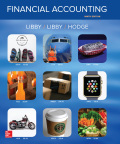
Financial Accounting
9th Edition
ISBN: 9781259738692
Author: Libby
Publisher: MCG
expand_more
expand_more
format_list_bulleted
Concept explainers
Textbook Question
Chapter 2, Problem 2.4E
Determining Financial Statement Effects of Several Transactions
The following events occurred for Johnson Company:
- a. Received investment of cash by organizers and distributed to them 1,000 shares of SI par value common stock with a market price of $40 per share.
- b. Purchased $15,000 of equipment, paying $3,000 in cash and owing the rest on accounts payable to the manufacturer.
- c. Borrowed $10,000 cash from a bank.
- d. Loaned $800 to an employee who signed a note.
- e. Purchased $13,000 of land: paid $4,000 in cash and signed a mortgage note for the balance.
Required:
For each of the events (a) through (e), perform transaction analysis and indicate the account, amount, and direction of the effect (+ for increase and − for decrease) on the

Expert Solution & Answer
Want to see the full answer?
Check out a sample textbook solution
Students have asked these similar questions
What is its current yield of these financial accounting question?
Solve this questions
ans
Chapter 2 Solutions
Financial Accounting
Ch. 2 - Prob. 1QCh. 2 - Define the following: a. Asset b. Current asset c....Ch. 2 - Explain what the following accounting terms mean:...Ch. 2 - Why are accounting assumptions necessary?Ch. 2 - For accounting purposes, what is an account?...Ch. 2 - What is the fundamental accounting model?Ch. 2 - Prob. 7QCh. 2 - Explain what debit and credit mean.Ch. 2 - Prob. 9QCh. 2 - Prob. 10Q
Ch. 2 - Prob. 11QCh. 2 - Prob. 12QCh. 2 - How is the current ratio computed and interpreted?Ch. 2 - Prob. 14QCh. 2 - Prob. 1MCQCh. 2 - Which of the following is not an asset? a....Ch. 2 - Total liabilities on a balance sheet at the end of...Ch. 2 - The dual effects concept can best be described as...Ch. 2 - The T-account is a tool commonly used for...Ch. 2 - Prob. 6MCQCh. 2 - The Cash T-account has a beginning balance of...Ch. 2 - Prob. 8MCQCh. 2 - At the end of a recent year, The Gap, Inc.,...Ch. 2 - Prob. 10MCQCh. 2 - Matching Definitions with Terms Match each...Ch. 2 - Matching Definitions with Terms Match each...Ch. 2 - Identifying Events as Accounting Transactions...Ch. 2 - Classifying Accounts on a Balance Sheet The...Ch. 2 - Determining Financial Statement Effects of Several...Ch. 2 - Prob. 2.6MECh. 2 - Prob. 2.7MECh. 2 - Prob. 2.8MECh. 2 - Prob. 2.9MECh. 2 - Prob. 2.10MECh. 2 - Prob. 2.11MECh. 2 - Computing and Interpreting the Current Ratio...Ch. 2 - Identifying Transactions as Investing or Financing...Ch. 2 - Matching Definitions with Terms Match each...Ch. 2 - Identifying Account Titles The following are...Ch. 2 - Classifying Accounts and Their Usual Balances As...Ch. 2 - Determining Financial Statement Effects of Several...Ch. 2 - Determining Financial Statement Effects of Several...Ch. 2 - Recording Investing and Financing Activities Refer...Ch. 2 - Prob. 2.7ECh. 2 - Recording Investing and Financing Activities...Ch. 2 - Analyzing the Effects of Transactions In...Ch. 2 - Analyzing the Effects of Transactions In...Ch. 2 - Prob. 2.11ECh. 2 - Inferring Investing and Financing Transactions and...Ch. 2 - Recording Journal Entries Nathanson Corporation...Ch. 2 - Prob. 2.14ECh. 2 - Analyzing the Effects of Transactions Using...Ch. 2 - Prob. 2.16ECh. 2 - Prob. 2.17ECh. 2 - Prob. 2.18ECh. 2 - Inferring Typical Investing and Financing...Ch. 2 - Prob. 2.20ECh. 2 - Identifying the Investing and Financing Activities...Ch. 2 - Prob. 2.22ECh. 2 - Identifying Accounts on a Classified Balance Sheet...Ch. 2 - Determining Financial Statement Effects of Various...Ch. 2 - Prob. 2.3PCh. 2 - Prob. 2.4PCh. 2 - Prob. 2.5PCh. 2 - Prob. 2.6PCh. 2 - Prob. 2.1APCh. 2 - Determining Financial Statement Effects of Various...Ch. 2 - Recording Transactions in T-Accounts, Preparing...Ch. 2 - Prob. 2.4APCh. 2 - Accounting for the Establishment of a New Business...Ch. 2 - Prob. 2.1CPCh. 2 - Prob. 2.2CPCh. 2 - Prob. 2.3CPCh. 2 - Prob. 2.4CPCh. 2 - Prob. 2.5CPCh. 2 - Prob. 2.6CPCh. 2 - Prob. 2.7CPCh. 2 - Prob. 2.8CP
Knowledge Booster
Learn more about
Need a deep-dive on the concept behind this application? Look no further. Learn more about this topic, accounting and related others by exploring similar questions and additional content below.Similar questions
arrow_back_ios
SEE MORE QUESTIONS
arrow_forward_ios
Recommended textbooks for you
- Principles of Accounting Volume 1AccountingISBN:9781947172685Author:OpenStaxPublisher:OpenStax College
 Financial Reporting, Financial Statement Analysis...FinanceISBN:9781285190907Author:James M. Wahlen, Stephen P. Baginski, Mark BradshawPublisher:Cengage Learning
Financial Reporting, Financial Statement Analysis...FinanceISBN:9781285190907Author:James M. Wahlen, Stephen P. Baginski, Mark BradshawPublisher:Cengage Learning Financial Accounting: The Impact on Decision Make...AccountingISBN:9781305654174Author:Gary A. Porter, Curtis L. NortonPublisher:Cengage Learning
Financial Accounting: The Impact on Decision Make...AccountingISBN:9781305654174Author:Gary A. Porter, Curtis L. NortonPublisher:Cengage Learning - Century 21 Accounting Multicolumn JournalAccountingISBN:9781337679503Author:GilbertsonPublisher:Cengage
 Cornerstones of Financial AccountingAccountingISBN:9781337690881Author:Jay Rich, Jeff JonesPublisher:Cengage Learning
Cornerstones of Financial AccountingAccountingISBN:9781337690881Author:Jay Rich, Jeff JonesPublisher:Cengage Learning

Principles of Accounting Volume 1
Accounting
ISBN:9781947172685
Author:OpenStax
Publisher:OpenStax College

Financial Reporting, Financial Statement Analysis...
Finance
ISBN:9781285190907
Author:James M. Wahlen, Stephen P. Baginski, Mark Bradshaw
Publisher:Cengage Learning

Financial Accounting: The Impact on Decision Make...
Accounting
ISBN:9781305654174
Author:Gary A. Porter, Curtis L. Norton
Publisher:Cengage Learning

Century 21 Accounting Multicolumn Journal
Accounting
ISBN:9781337679503
Author:Gilbertson
Publisher:Cengage


Cornerstones of Financial Accounting
Accounting
ISBN:9781337690881
Author:Jay Rich, Jeff Jones
Publisher:Cengage Learning
The accounting cycle; Author: Alanis Business academy;https://www.youtube.com/watch?v=XTspj8CtzPk;License: Standard YouTube License, CC-BY